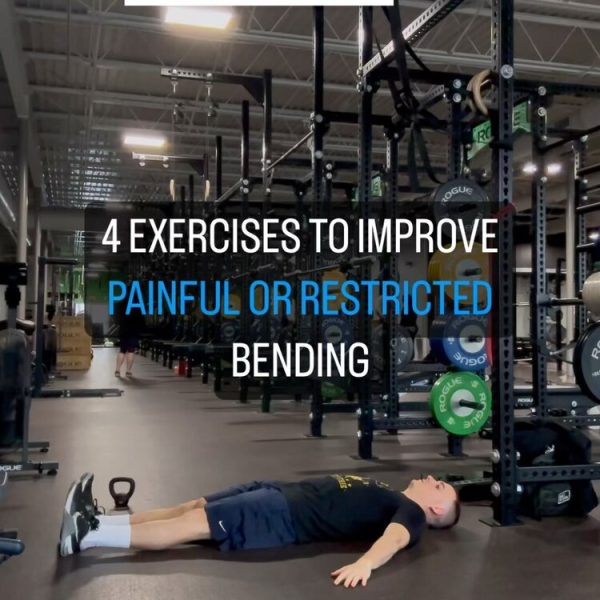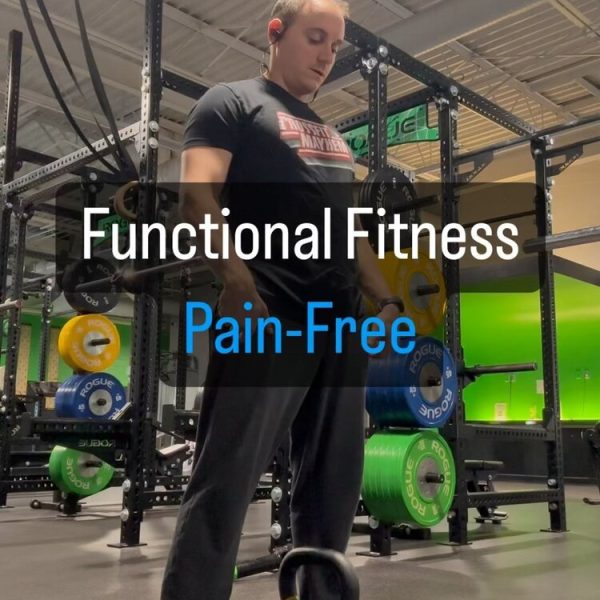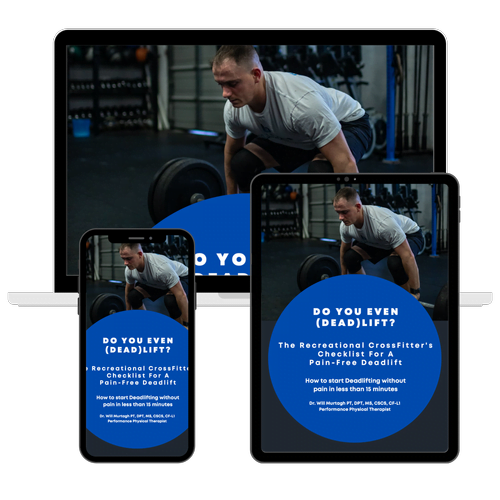Dr. Will Murtagh is a performance physical therapist and writer who helps Fitness Athletes elevate their fitness and train pain-free.
Accessory exercises are a critical component of CrossFit athletes’ training programs. A CrossFit accessory workout can complement the high-intensity functional movements found in traditional CrossFit workouts.
Although CrossFit emphasizes compound movements involving multiple joints, like squats and deadlifts, incorporating accessory programs can address weak muscle groups and faulty movement patterns necessary for overall strength, stability, and injury prevention.
By incorporating accessory movements such as Bulgarian Split Squats, Glute Bridges, and Good Mornings into your training program, you can isolate and strengthen muscle groups that may hold back your performance or cause discomfort during CrossFit workouts, such as the glutes, hamstrings, shoulder muscles, and lower back.
You’ll find this in exercises like Single-Leg Romanian Deadlifts, Single-Arm Dumbbell Shoulder Press, or Suitcase Carries, where balance and control are improved with strengthening.
The increased stability from incorporating accessory movements can reduce the risk of injury by addressing weak points and movement faults that can contribute to overuse injuries. (1) Thus, adding accessory exercises like the ones I’ll mention below can improve your movement, fortify your joints, and help you continue to train pain-free.
In this article, we will dive into the importance of accessory workouts, the key factors to consider, and the most common ones I include in my clients’ training programs that I have learned over the last 12 years of training and coaching CrossFit.
What Is A CrossFit Accessory Workout?
A CrossFit accessory workout typically consists of supplementary exercises that target specific muscle groups or movement patterns that must be adequately addressed in traditional CrossFit workouts.
These workouts utilize single-joint movements not typically found inside a traditional CrossFit program. These can include bicep curls, tricep extensions, and calf raises.
However, you can also use compound movements that are not common in CrossFit program design, such as Good Mornings and Split Squats, which are compound in nature but emphasize various muscle groups.
Accessory programs can be done with your typical routine or as an add-on during recovery days to promote recovery and fortify a weak link in your movement. These are a great way to individualize your training and ensure you’re making progress toward your goals.
The Best Accessory Movements To Include In Training
Lower Body Movements
Split Squat
- Stand in a split stance, your feet hip-width apart.
- Take a big step backward with one foot and place the top of your foot on a bench or elevated surface behind you.
- Keep your torso upright and engage your core for stability.
- Lower your body by bending both knees until your back knee nearly touches the ground and your front thigh is parallel.
- Push through your front heel to return to the starting position.
- Complete the desired repetitions on one leg before switching to the other.
Watch a demo video (LINK)
Glute Bridge
- Lie on your back with your knees bent and feet flat on the ground, hip-width apart.
- Engage your core and squeeze your glutes as you lift your hips off the ground, creating a straight line from your shoulders to your knees.
- Hold the bridge position momentarily, ensuring your hips are fully extended.
- Slowly lower your hips back down to the starting position.
- Repeat for the desired number of repetitions.
Watch a demo video (LINK)
Good Mornings
- Stand with your feet shoulder-width apart and place a barbell across your upper back, resting it comfortably on your traps.
- Engage your core and keep your back straight throughout the movement.
- With a slight bend in your knees, hinge at your hips and lower your torso forward until it’s almost parallel to the ground. Keep your chest up and your gaze forward.
- Lower your torso until you feel a stretch in your hamstrings, but avoid rounding your back.
- Once you reach the bottom position, drive through your heels and squeeze your glutes to return to the starting position.
- Keep the movement controlled and avoid hyperextending your lower back.
- Repeat for the desired number of repetitions.
Watch a demo video (LINK)
Upper Body Movements
Single Arm Dumbbell Bench Press
- Begin by lying flat on a bench with a dumbbell in one hand.
- Position your feet firmly on the ground for stability.
- Engage your core and keep your shoulders and hips square throughout the movement.
- Hold the dumbbell directly above your chest with your arm fully extended.
- Lower the dumbbell in a controlled manner towards the center of your chest while maintaining stability and keeping your elbow at a 45-degree angle to your body.
- Once the dumbbell is near your chest, press it back up to the starting position, fully extending your arm.
- Keep your movements slow and controlled, focusing on engaging the chest muscles.
- Complete the desired number of repetitions on one side before switching to the other side.
Watch a demo video (LINK)
Single Arm Dumbbell Shoulder Press
- Begin by sitting on a bench with back support or standing with feet shoulder-width apart.
- Hold a dumbbell in one hand at shoulder height with your palm facing forward and your elbow bent.
- Engage your core for stability and ensure your back is straight.
- Press the dumbbell overhead, extending your arm upward and straightening your elbow.
- Keep your wrist aligned with your forearm throughout the movement.
- Once the dumbbell is fully extended overhead, pause briefly at the top.
- Slowly lower the dumbbell back to the starting position, maintaining control.
- Repeat for the desired number of repetitions on one side before switching to the other side.
Watch a demo video (LINK)
Bent Over Barbell Row
- Begin by standing with your feet shoulder-width apart, toes pointed slightly outward.
- Position a barbell on the floor before you and stand over it with your shins close to the bar.
- Bend at your hips and knees to grip the barbell with an overhand grip, slightly wider than shoulder-width apart.
- Keep your back straight, chest up, and shoulders pulled back to maintain a neutral spine.
- Engage your core muscles for stability.
- With your arms fully extended and elbows slightly bent, lift the barbell off the ground by driving your elbows back and pulling the bar towards your lower chest or upper abdomen.
- Keep the movement controlled, and avoid using momentum or swinging the weight.
- Squeeze your shoulder blades together at the top of the movement to fully engage your upper back muscles.
- Slowly lower the barbell back to the starting position, maintaining control.
- Repeat for the desired number of repetitions.
Watch a demo video (LINK)
Core Movements
Reverse Hyper
- Lie face down on a bench or stability ball with your legs extended straight behind you and your toes touching the ground.
- Grip the sides of the bench or hold onto a stable surface for support.
- Engage your lower back and glutes as you lift your legs towards the ceiling, keeping them straight.
- Squeeze your glutes at the top of the movement before slowly lowering your legs.
- Maintain control throughout the exercise to prevent swinging.
- Repeat for the desired number of repetitions.
Watch a demo video (LINK)
Hollow Holds
- Lie on a mat with your arms extended overhead and your legs straight out.
- Engage your core muscles by pressing your lower back into the mat.
- Lift your shoulders and legs a few inches off the ground, keeping them hovering above the mat.
- Raise your head, neck, and shoulders off the ground, looking toward your toes.
- Keep your arms straight and parallel to the ground, reaching them towards your feet.
- Point your toes and squeeze your legs together, keeping them straight.
- Maintain tension throughout your body, pressing your lower back into the ground.
- Hold this position for the desired duration, aiming to keep your body as straight and flat as possible.
- Focus on breathing steadily throughout the hold.
Watch a demo video (LINK)
Suitcase Carry
- Stand tall with a dumbbell or kettlebell in one hand, down by your side, as if carrying a suitcase.
- Engage your core muscles to maintain stability and keep your shoulders square.
- Ensure your grip on the weight and your arm is fully extended.
- Keep your chest up and your back straight throughout the exercise.
- Take slow and controlled steps forward, walking in a straight line.
- Maintain an upright posture and avoid leaning toward the side with the weight.
- Keep your shoulders level and avoid allowing the weight to pull you to one side.
- Walk for a predetermined distance or time, ensuring you maintain proper form.
- Once you have completed the desired distance or time, switch the weight to the other hand and repeat the exercise.
Watch a demo video (LINK)
CrossFit Accessory Program Considerations
Frequency
Everyone is different regarding how frequently you should incorporate accessory workouts based on your needs and goals. In some instances, accessory workouts may not be needed after several hours of fortifying weak areas.
However, training a movement pattern 1-3 times per week will suffice either on a designated accessory day or in conjunction with your current programming. (2) Combining movements like a suitcase carry with a back squat or an external rotation with pull ups can keep your sessions efficient rather than adding additional sessions.
Intensity
The intensity of your accessory workouts and the movements you train are based on the effect you are looking to create. For example, how much weight you will need depends on whether you want to build motor control, strength, and muscle endurance. They can range from lower intensity to higher intensity based on the goals of the workout.
Volume
The total training volume of a workout refers to the total amount of work done during the workout. The volume is affected by the number of sets, reps, and exercises. High volumes with more sets and reps will build motor control, endurance, and muscle mass, while lower-volume workouts with fewer sets and higher intensity will build strength. (3)
Tempo
Tempo refers to the speed at which each repetition and phase of the exercise are performed. Each exercise will include eccentric (descent), concentric (ascent), and isometric (pausing) phases that occur at various speeds during the movement. (4)
Even during exercises without a “pause,” an isometric portion occurs as you reverse directions to complete the motion. By manipulating tempo in your accessory programs, you can increase time under tension, enhance muscle activation, and develop control and stability.
Final Thoughts on CrossFit Accessory Workouts
Utilizing consistent accessory work can be the missing piece for functional fitness athletes looking to train hard long-term and stay pain-free while they do it. The nine exercises I’ve mentioned are typical examples of the best accessory exercises I incorporate into my client’s training programs inside my 1:1 Pain-Free Performance Program.
Accessory work, such as isolation exercises and unilateral work, can keep your joints performing well and moving through their full range of motion without discomfort. Ultimately, this enhances the biomechanics of each movement and avoids compensations and unnecessary forces on joints they were not designed to endure.
Although a typical CrossFit class may not incorporate accessory work into their programming, the good news is that you now have the tools you need to do them on your own.
Whether that is first thing before the class starts or after the class ends before you head home for the day, adding these movements into your training can build a more well-rounded approach to fitness, leading to improved performance and reduced risk of injury in CrossFit and beyond.
If you need more help with training CrossFit without the joint pain that can come with it, then I invite you to book a free consultation HERE to see how my 1:1 Pain-Free Performance program can help you train hard without pain so that you can keep making progress towards your goals.
References:
1. Neme J. R. (2022). Balancing Act: Muscle Imbalance Effects on Musculoskeletal Injuries. Missouri medicine, 119(3), 225–228. https://www.ncbi.nlm.nih.gov/pmc/articles/PMC9324710/
2. Ralston, G. W., Kilgore, L., Wyatt, F. B., Buchan, D., & Baker, J. S. (2018). Weekly Training Frequency Effects on Strength Gain: A Meta-Analysis. Sports medicine – open, 4(1), 36. https://doi.org/10.1186/s40798-018-0149-9
3. Hughes, D. C., Ellefsen, S., & Baar, K. (2018). Adaptations to Endurance and Strength Training. Cold Spring Harbor perspectives in medicine, 8(6), a029769. https://doi.org/10.1101/cshperspect.a029769
4. Ralston, G. W., Kilgore, L., Wyatt, F. B., Buchan, D., & Baker, J. S. (2018). Weekly Training Frequency Effects on Strength Gain: A Meta-Analysis. Sports medicine – open, 4(1), 36. https://doi.org/10.1186/s40798-018-0149-9













